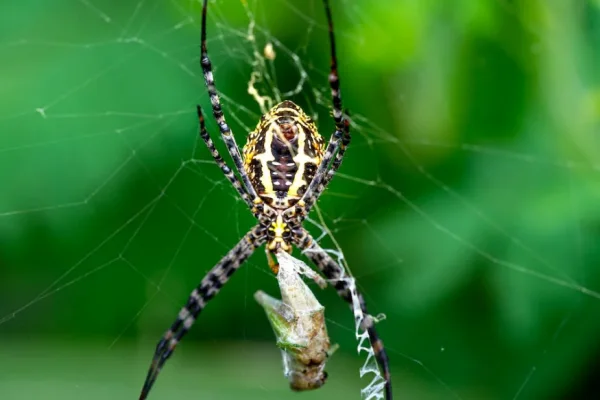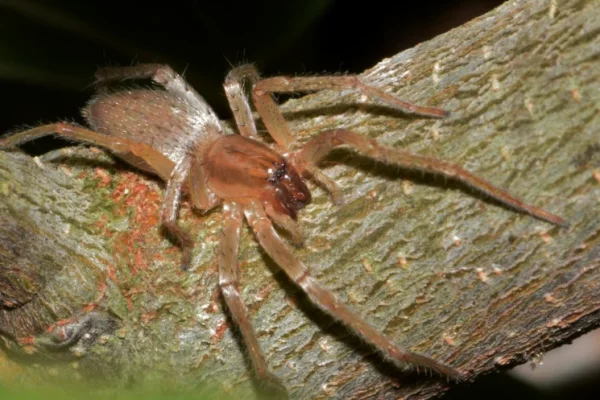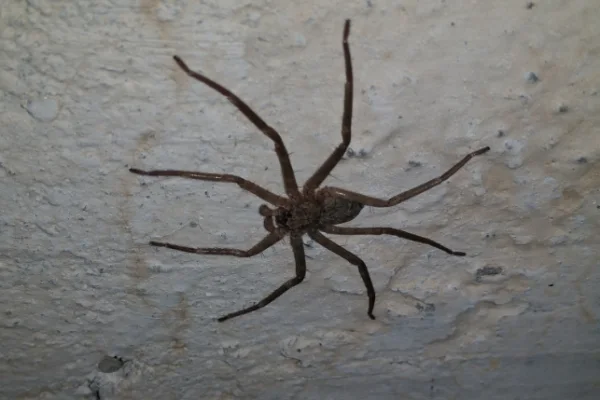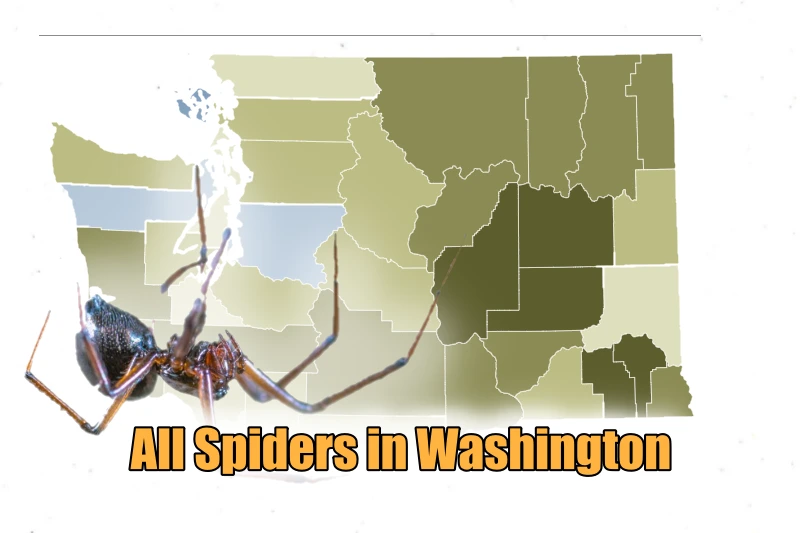Washington is not only a city of monuments and memorials, but it also holds a great biodiversity, which makes this state distinct. While searching for spiders, I learned about the different spider species found in Washington. These spider species are so interesting that you will be astounded to learn about their incredible stories.
I got spellbound by learning about these enchanting creatures. Here is a list of 31 spiders found in Washington, according to Spider ID. So let us begin this fantastic voyage with spiders.
All Spiders in Washington
1. Alopecosa kochi
| Scientific name | Alopecosa kochi |
| Size | 6.6 to 11 mm |
| Identification | It has a broad white central band down the middle of its carapace |
| Diet in the Wild | Crickets, grasshoppers, beetles, flies and other spiders |
2. Cross Orb-weaver
| Scientific name | Araneus diadematus |
| Size | 5.5 to 20 mm |
| Identification | It has white markings on its abdomen and a cross-pattern |
| Diet in the Wild | Primarily Flying insects |
3. Cat-faced spider
| Scientific name | Araneus gemmoides |
| Size | 0.2 to 0.98 inches |
| Identification | The center pattern on the abdomen forms the face-like pattern |
| Diet in the Wild | Insects, Other Arachnids, and cannibalism are also seen |
4. Araneus saevus
| Scientific name | Araneus saevus |
| Size | 14 to 15 mm |
| Identification | They have median lines and humps on their abdomen on the dorsal side |
| Diet in the Wild | flies and other forest insects |
5. Six-spotted Orb-weaver
| Scientific name | Araniella displicata |
| Size | 4 to 8 mm |
| Identification | They have six black spots, which are lined with lighter colors and are present on the abdomen |
| Diet in the Wild | small insects like beetles, plant bugs, and flies |
6. Banded Garden Spider

| Scientific name | Argiope trifasciata |
| Size | 4 to 20 mm |
| Identification | It has silvery setae that are present on its back |
| Diet in the Wild | aphids, flies, grasshoppers, and Hymenoptera |
7. Callobius severus
https://in.pinterest.com/pin/387942955379958593/
| Scientific name | Callobius severus |
| Size | up to 19 mm |
| Identification | They have reddish-brown legs and cephalothorax |
| Diet in the Wild | Invertebrates like pill bugs |
8. Long-legged Sac spider

| Scientific name | Cheiracanthium mildei |
| Size | 7 to 10 mm |
| Identification | The groove on the Carapace is absent and the first pair of legs are the longest |
| Diet in the Wild | flies, moths, crickets, and insects |
9. Woodlouse Hunter
| Scientific name | Dysdera crocata |
| Size | 9 to 15 mm |
| Identification | They have tightly arranged six eyes and long fangs |
| Diet in the Wild | woodlice, silverfish, earwigs, millipedes, burying beetles and crickets |
10. Candy-striped spider
| Scientific name | Enoplognatha ovata |
| Size | up to 6 mm |
| Identification | They have translucent legs and creamish white abdomen with different color markings |
| Diet in the Wild | Pollinating Bees and Flies |
11. Hobo spider
| Scientific name | Eratigena agrestis |
| Size | 8 to 15 mm |
| Identification | They have a herringbone pattern on the dorsal side of the abdomen |
| Diet in the Wild | House flies, Cockroaches, Silverfish, Beetles, Praying mantises, Black and yellow dauber wasps |
12. Giant house spider

| Scientific name | Eratigena atrica |
| Size | 12 to 18 mm |
| Identification | Have swollen palps at their leg ends |
| Diet in the Wild | crickets, flies, moths, invertebrates, and small birds |
13. Eratigena duellica

| Scientific name | Eratigena duellica |
| Size | 10 to 18 mm |
| Identification | They have yellow median stripes that are present all across the body |
| Diet in the Wild | Flies, moths, crickets, invertebrates, small birds, bedbugs, cockroaches, and earwigs |
14. Western Parson spider
| Scientific name | Herpyllus propinquus |
| Size | up to 8.42 mm |
| Identification | They have a white or silvery stripe on the back of the abdomen |
| Diet in the Wild | crickets, ants, grasshoppers, and other invertebrates |
15. Larinioides patagiatus
| Scientific name | Larinioides patagiatus |
| Size | 5.5 to 11 mm |
| Identification | They have yellow to brown abdomens with dark folium markings on dorsal side |
| Diet in the Wild | Chironomids |
16. Golden-rod Crab spider
| Scientific name | Misumena vatia |
| Size | 3 to 9 mm |
| Identification | They have white abdomens with two colored stripes |
| Diet in the Wild | insects |
17. Eared Dome sheet-web spider
| Scientific name | Neriene digna |
| Size | 3.5 to 5 mm |
| Identification | They have a pair of large discs near mouthparts that look like ears |
| Diet in the Wild | Pollen and nectar-feeding insects |
18. Sierra Dome spider
| Scientific name | Neriene litigiosa |
| Size | 5 to 8 mm |
| Identification | They have a white abdomen with a black median stripe all across it |
| Diet in the Wild | On some flies |
19. Phanias harfordi
| Scientific name | Phanias harfordi |
| Size | Up to 5 mm |
| Identification | It has a white margin on its abdomen |
| Diet in the Wild | Insects and other small arthropods |
20. Bold jumper
| Scientific name | Phidippus audax |
| Size | 6 to 15 mm |
| Identification | They have big eyes and are iridescent blue Jaws |
| Diet in the Wild | Insects and other spiders |
21. Johnson Jumping spider
| Scientific name | Phidippus johnsoni |
| Size | 9 to 14 mm |
| Identification | They have a bright red abdomen |
| Diet in the Wild | flies, bugs, moth caterpillars, and other spiders |
22. Long-bodied Cellar spider
| Scientific name | Pholcus phalangioides |
| Size | 6 to 10 mm |
| Identification | They have thin and elongated legs |
| Diet in the Wild | insects, other spiders, and other small invertebrates |
23. Zebra jumper
| Scientific name | Salticus scenicus |
| Size | 4 to 7 mm |
| Identification | They have black or brown abdomen with white markings that give them a zebra-like appearance. |
| Diet in the Wild | Other spiders, moths, mosquitoes, and other arthropods |
24. Mouse spider
| Scientific name | Scotophaeus blackwalli |
| Size | 9 to 12 mm |
| Identification | Their hairy abdomen resembles mouse furs |
| Diet in the Wild | ants, beetles, tiny reptiles, and frogs |
25. Scytodes thoracica
| Scientific name | Scytodes thoracica |
| Size | 3 to 6 mm |
| Identification | They have dark patterns on light-colored legs |
| Diet in the Wild | Moths, Flies, other spiders, household bugs, and their own eggs (sometimes) |
26. Sergiolus montanus
| Scientific name | Sergiolus montanus |
| Size | 6 to 10 mm |
| Identification | They can be identified by observing their genitalia |
| Diet in the Wild | insects and other small invertebrates |
27. White-spotted False Widow
| Scientific name | Steatoda albomaculata |
| Size | 3.3 to 6.5 mm |
| Identification | They have a white-reddish pattern on their dark Opisthosoma |
| Diet in the Wild | flies, mosquitoes, moths, ants, and other insects |
28. Rabbit-Hutch Spider
| Scientific name | Steatoda bipunctata |
| Size
|
4.4 to 7.3 mm |
| Identification | They have dark stripes on their legs and a light band is present on the center of their abdomen |
| Diet in the Wild | other spiders, crickets, ladybugs, cockroaches, and woodlice |
29. False black widow
| Scientific name | Steatoda grossa |
| Size | 6 to 10.5 mm |
| Identification | They have triangular patterns on their abdomen |
| Diet in the Wild | Pill bugs and woodlice |
30. Triangulate Cobweb spider
| Scientific name | Steatoda triangulosa |
| Size | 3.5-5.9 mm |
| Identification | They have a triangle-shaped pattern on the dorsal side of the abdomen |
| Diet in the Wild | ticks, spiders (like brown recluses), pill bugs, and Small insects |
31. Trochosa terricola
| Scientific name | Trochosa terricola |
| Size | 7 to 14 mm |
| Identification | It has two short lines on its carapace |
| Diet in the Wild | Insects like other small spiders, ants, and grasshoppers |
Conclusion
Here I conclude our article on all the spider species found in Washington. As you can see, Washington is not only known for its incredible landscapes, but it is also the home of many spider species.
I hope you enjoyed reading this post. So next time you encounter these animals, don’t get scared of them. Instead, pay close attention to them and discover the mysteries they conceal.
Frequently Asked Questions:
Q1) Are there poisonous spiders in Washington?
Ans. Black Widow, Hobo spider (Eratigena agrestis), and Cheiracanthium inclusum (Black-footed Yellow Sac Spider) are some of the poisonous spiders found in Washington.
Q2) What is the most common spider in Washington State?
Ans. Hobo spiders, jumping spiders, Yellow sac spiders, Funnel weavers, and black widow spiders are the most common species found in Washington.
Q3) Are spiders common in Washington?
Ans. Yes, spiders are very common in Washington state. The five most common spiders found in Washington are Hobo spiders, Jumping spiders, Yellow sac spiders, Funnel weaver, and black widow spiders.
Q4) What spiders does Washington State have?
Ans. According to Spider ID, there are 31 species of spiders found in Washington state, including Wolf spiders, Giant house spiders, cellar spiders, and hobo spiders, etc.
Q5) Do wolf spiders bite?
Ans. Yes, wolf spiders can bite but they are not that aggressive. They usually do so when they feel threatened or cornered.
Q6) How bad is a black widow’s bite?
Ans. Black Widow spider is highly venomous and it’s venom directly or indirectly affects the nervous system of the victim. It leads to various complications like serious pain, swelling, redness, etc.
Q7) Are there a lot of spiders in Seattle?
Ans. Yes, there are a lot of spiders in Seattle. Some of them are Cross Orb Weaver, Zebra jumping spiders, Giant house spiders, Sierra dome spiders, etc.
Q8) Are American house spiders harmless?
Ans. American house spiders are harmless to humans; their bite doesn’t cause any serious or severe symptoms, it is similar to the typical insect bite. They are not that aggressive and only bite when it is provoked.
Q9) Are there big spiders in Washington?
Ans. Yes, Big spiders are also present in Washington state, like Giant house spider, hobo spider, Ground wolf spider, Long-legged cellar spider, Trapdoor spider, etc.
Some Interesting facts about spiders
1) Do all spiders produce silk?
The question must have arisen in your brain: do all spiders produce silk? Let me tell you that these spiders produce silk through their specialized silk glands present in their abdomen and use this for various purposes like making webs, egg sacs, cocoons, etc.
2) Do all spiders make webs?
The answer is no. Though all spiders produce silk, not all of them make webs. Some of them made egg sacs with it, wrapped prey in it, helped spread their young, and utilized it as a safety line to help them flee from predators.
3) Do they eat each other?
The most interesting thing about spiders is that some species are known for cannibalizing their mates. Black widow females usually eat their mates after mating.
4) Why spiders vision is different from others animals?
Now come to the vision. Spiders vision is so different from that of vertebrates as well as from that of insects. Though they typically have eight eyes, But only a few of them have good eyesight.
Others heavily depend on vibrations, scent, and taste to sense their surroundings. They are able to see in both green and ultraviolet light, which is far beyond the spectrum in which humans can see.
5) Do they sing and dance also?
You will be amazed to know that spiders can even sing and dance. Amazing, isn’t it?
Spiders generally dance in order to attract their mates and warn their predators. and also sing or practically produce sound in order to attract the female spider by vibrating their long legs and abdomen; if she likes the singing, then they mate; if not, then probably she will eat him.
6) Phobia of Spiders
Some people are very scared of spiders. You must have heard someone say, Oh my god, the spider is here. This phobia of spiders is known as arachnophobia.
7) Ants mimic spiders; do they exist?
Yes, even some spiders mimic ants. But why? Myrmarachne is one of the genus of jumping spiders that mimic ants. They resemble the ants in terms of their appearance and behavior; they even do that zig-zag locomotion that ants often do.
But the question is: Why do they do it? Firstly, they can eat them while living between them, and another reason is that it also protects them from predators.
8) Silk web strength
The silk webs that they produce are very strong. It is known to be 1/6th as dense as steel, which makes it very strong for its weight.
9) Their venomous nature
Now let’s talk about their venom. Most people who are scared of spiders do so because of one reason: they are venomous.
It’s true that most of them do produce venom, but the majority of them are not harmful to humans or any other mammals.
According to Guinness World Records, the Sydney funnel-web spider is the most dangerous spider for humans, and it is known to cause a lot of human deaths in Sydney.
10) Their interesting mating ritual
Spiders’ mating ritual is the most fascinating aspect of their behavior. Males typically dance or sing in front of females to impress them.
The mating process of the peacock spider lasts 50 minutes. And after great effort to please the ladies, the females kill them after mating.
But why? Because it keeps reproductive possibilities open.
References:
- https://spiderid.com/locations/united-states/washington/
- Wikipedia
Also Read:

Being a zoology student I’m always been fascinated toward animals especially insects. I love to do research and learn about different animals. As a writer I want to share my thoughts about nature through my articles. Apart from this you can find me exploring the new places and voice notes.

